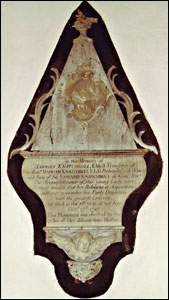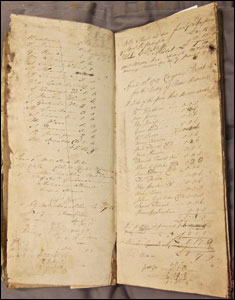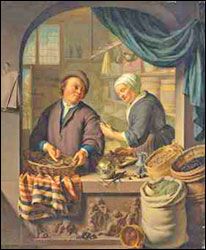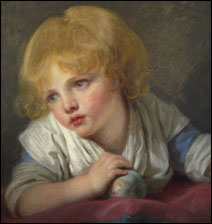Cosgrove is fortunate in having a copy of the various Overseers of the Poor accounts from 1787 to 1800. These few years give a snapshot of the poorest families in the village and the systems in place to support them at this time. From the accounts we have extracted stories of real people and their difficulties.
 |
Remarkably, in Cosgrove Church is a monument to Harriet Knatchbull. She was the granddaughter of Sir Edward Knatchbull of Kent, who steered an Act through Parliament in 1723 which allowed parishes to stipulate that those who required relief had to go into a workhouse and work for the parish in return, and to open parochial cottage workhouses. This is sometimes called the Workhouse Test Act.
By the start of the 18th century JPs had to supervise Poor Relief locally. Each parish was ordered to levy a tax on householders to raise a fund.
From this levy, overseers were appointed and paid to manage the “parish relief” system – which we would call “benefits” today. In Cosgrove they kept very detailed records of money, rent, food, fuel, clothing, travel costs and other things supplied to support people in the village.
|
|
 |
The Overseers worked out how much would be needed from the previous year’s expenditure and collected and recorded how much residents had paid in the levy, at the “rate” of so much in the pound estimated at each householder’s property value. This later, of course, became the “Rates”. The whole account was checked and countersigned by the current owner of the manorial rights – in Cosgrove’s case, John Christopher Mansel III.
Overseers had to spend the money on the sick and aged and on work creation, helping people within their own homes in villages. They were to arrange for orphaned children to be looked after locally and then apprenticed to suitable trades.
|
|
Families were attached to the Parish for life – they needed a certificate to move unless they were householders. The Parish rented two cottages for the Poor on what is now Main Street, next to Lock Lane.
The sick, elderly and infirm were cared for in
poorhouses but the able-bodied poor were given poor relief in their own homes.
The Parish cottages were maintained by the village, and payments appear in the accounts for services such as thatching and “cleaning out the Necessary”.
|
A parliamentary report of 1777 recorded parish workhouses in operation at Cosgrove (for up to 9 inmates).
|
|
|
Older residents of Cosgrove born in the village can remember these cottages, still standing in the 1940’s. They were condemned in the 1920’s, but nothing was done about them, and they were occupied by evacuee families during WW2.
The Potterspury Poor Law Union was formed on 20th May 1835. A building at Yardley Gobion became the workhouse, and Cosgrove paupers were moved into it.
|
The following stories really happened in Cosgrove.
All the names are of real people.
No other traces of them remain – they have no grave markers. They may at this time be resident in Cosgrove or in Old Stratford.
The case of David Thompson from Kempston
In 1793 the Cosgrove Overseer, Richard Scrivener, paid for David Thompson, who was then living in Cosgrove having come from Kempston in Bedfordshire, to be escorted to Stony Stratford by James Ship and Toombs, and for a marriage licence. This seems likely to have been something of a shotgun wedding as an escort was required! The bride and groom were given £1 16s 6d by the Overseer.
Next, David Thompson was taken to Northampton, possibly to the Justices, during which time his board and lodging at Mrs Willason’s [probably Mrs Willison of the Falcon Inn Old Stratford] was paid for. His origins in Bedfordshire must have come to light, as a removal order was made to send Thompson and his wife to Harrold village in Bedfordshire. The poor at this time had no rights of residence outside their County of birth.
 |
Cosgrove parish paid for the Thompsons’ travel to Harrold, including hay and corn for horses for themselves and the overseer, but David was soon back and being paid for at Mrs Willison’s.
The final entries regarding David Thompson record the expenses incurred at Quarter sessions in Northampton and a trial, presumably to compel him to leave Cosgrove for good.
|
Sarah Dury’s family
Sarah Dury lived in Cosgrove with her husband John and their small daughters. They were poor and occasionally received help from the parish. In 1789 while John was ill, Sarah was given 5s and the help of a woman called Jane Lawrence was paid for, possibly because Sarah was pregnant or nursing her youngest daughter Elizabeth, born late in that year.
In 1790 Mary Jones was paid 2s 6d for sheets and shirts for the family, and Robert Cockerill 12s 6d for shoes for the parents.
In the following year the parlous state of the children must have come to the attention of the Church, who ordered by a “vestrey” additional shoes for the children from William Dickens. The Church seems to have been able to over-ride some decisions of the overseer. The Dury family’s bread bill was also paid for them.
 |
In 1792 the family, John and Sarah and the girls, Mary aged 8, Martha aged 6 and Elizabeth aged 2, hit further problems. John being ill, they received additional money, and shop goods including candles and sugar. They were also given 27 Faggots, which were bundles of firewood of specified size especially bought in for the poor.
Despite this, John’s health declined and Jane Lawrence was once again brought in, along with James Curtis, to “sit up” with him. When he died, Jane was paid to lay him out, go to Paulerspury for the Coroner and to find a witness to make an affidavit to confirm his death.
|
The village paid for all the funeral expenses, which were very basic.
| Mr Nasby Bill Shrouds for Dury and Curtiss Child |
7s |
| Gave 4 Men 6d each to Carry Jn Dury to Church |
2s |
| pd Wm Jones for Dury Coffin |
10s |
| pd Turvey for Dury Burying & tax |
2s 3d |
| pd for Ale at Burying |
1s 4d |
|
|
By contrast, when the Duke of Grafton was buried just a few years later his coffin handles alone cost £114.
|
Sarah and the children continued to receive relief from the parish, first of which was clothes, possibly for decency at the funeral. The girls were provided with “gownes”, petticoats, shifts and aprons, and Sarah was given “9 Ells of Cloath at 1s 3d per E” to make her own.
It is possible that Sarah herself came from Towcester, as the village next paid for her and the girls to be taken there to lodge with a Mr Simco, which cost 5s 6d a week and was paid for in advance on their behalf.
This arrangement lasted just over a year, during which time the Doctor had to be called for “savin Wife”, as though her own health was already in jeopardy. The Cosgrove Overseer fetched the family back in 1794 and had to try “Homing” them. They were put on the standard “Poors List” at 5s weekly with additional faggots when it was cold. The Church ordered more clothes for the children occasionally and Sarah received additional money when she was ill.
By now Mary was being trusted with jobs like going to the solicitors in Stony Stratford with messages, presumably to try to raise the income of the family. Sarah was being provided with mutton and bread rather than money, although we can only surmise why.
By 1796 this arrangement came to an end. Mary, aged 12, Martha, aged 10 and Elizabeth aged 6 were provided with new shifts and taken to Whaddon, where they were enrolled in a lace school in the care of a Mr Stopps. Their food, lodging, tuition, clothing and lacemaking equipment were paid for by Cosgrove for a total of three years.
|
|
 |
Meanwhile, back in Cosgrove, Sarah was clearly in a dreadful state, and was taken to the house of a woman called Hannah Lineham, who was paid “for washing Sarah Dury and Rid her of Vermon” and “to bye sope to wash Sarah Durys Shurts &c”.
When Sarah’s children eventually returned from their lace school in 1799, the family continued to need support, and various trusted women were paid for “Cleaning Drurys Family, Boilering the Cloaths Destroying Vermun &c”, “mending & materials for Drurys family” and “making Drurys Childrens things”.
|
 |
The Parish continued to pay for Dury’s children to be boarded, probably separately from their mother, at 5s per week, until the end of the section of the Poor Book that we have in 1800.
The Battams Boy
In 1788 William Battams Osborn was born illegitimately. His father may have had another family in wedlock, as other Battams did live in Cosgrove at this time. His mother, Temperance Osborn, does not appear in Cosgrove church registers. From her name we could surmise that she may have been a non-conformist.
The Parish seems to have taken little William under their wing as an infant, and from 1795 he appears in the Poor Book as being looked after by Mrs Davies for 2s 6d weekly.
As he grew, the village supported him with new shoes, at 5s 9d, from Robert Cockerill and had these mended when need by Ed Coallens at 3s 6d. From the cost we can guess that these were of better quality than those usually provided from the levies. Later Mrs Davies received money for mending his clothes and also to buy a coat, waistcoat and a “pare of Britches”.
|
|
Extra money for William was sometimes awarded by the Church via the vestry system, and we can wonder if this was connected with another Battams who was Churchwarden. Mr Willis provided cloth for shirts at 6s 4½d and Mrs Dickins made it up into shirts at the cost of 2s.
By 1796 William was referred to in the Poor Book as “Young Battams”, which may imply that his father had no legitimate son alive. Mr Attkins was paid 11s 6d for a “Coat and Wascoat, Sleving and mending Coat and Cloath for Young Battams” , and like all boys, William’s breeches and shoes needed constant mending.
During 1797 the parish paid out £1 18s 8d for William’s clothing and in the following year £2 12 5d. This was the last entry for the Battams Boy, and thereafter he presumably reached a majority of sorts, at ten years old, receiving, through the standard Poors List 2s 6d weekly.
|
We do know that a William Battams of around the right age was later farming his own leased land in Passenham, and we can hope that this was our Cosgrove boy made good.
The Story of Anne Shaw
Also on the Poors List at this time, in 1794, was Anne Shaw, described as “ill”. However, there was clearly more to this case than this, as from October 1794 the Cosgrove Overseer was writing letters on her account to a Mr Bollon, for which 4d postage was payable for a single letter.
|
|
In December, she and an ex Churchwarden and his wife set off for London, and Anne was taken to the now infamous Bethlem Hospital costing the parish £3 9s 1d in total. Prior to this Ed Jones and the Overseer had to make a trip to Quinton to procure a “Cetificate” and get two Justices to sign it, presumably an early form of sectioning. |
| Anne was fortunate in being one of the very first patients at the new Hospital. Cosgrove paid £1 17s to have her admitted. Today we tend to think of the “Bedlam” Hospital as being a grim place of no return, but in fact the average stay there was around two years and many patients were apparently much improved. |
|
In 1795 Anne returned to Cosgrove and John Bayley’s wife Anne was paid 5s weekly to look after her. This arrangement lasted some months, but Anne Shaw’s last entry refers to John Durrant once again being paid his expenses in taking Anne to Bethlem once again.
Hannah Lineham’s story
Hannah has already appeared in this text, and is a good example of poor but able women who were receiving poor relief which was offset by their work for the parish in looking after less fortunate “Poors”. She was apparently born in Cosgrove around 1753, and may have been married to Joseph Liman in 1777, although spellings of this name varied wildly. By 1787 Joseph had apparently died or left Hannah, and she was claiming poor relief for clothing for her child, doctor’s visits and so on.
Perhaps because of her work with the sick, Hannah was sometimes given faggots and firewood by the parish. She must have lived in a larger cottage as people like Sarah Dury and an old woman called Mary Westley were brought to stay at Hannah’s house to be cared for rather than Hannah going out to them. Perhaps because of this, there are several entries in the Poor accounts for repairs to Hannah’s house. And they paid “Henerey Branson a bill for mason worke at Hanah Linome's Howse” at 4s and the same amount “for a Teame going to Mr Wilkerson for Brick and Lime for Hanah Linomes Howse”.
Hannah’s wage for a week of caring for Mary Westley was 1s 3d. A labourer’s daily wage at this time was 1s 4d, but the poor were always paid at a very much lower rate. |
|
Hannah nursed Mary until her death, when she was paid 6s for “Siting up with Marey Weasley and worshing up hur Things”. The parish also paid for Mary’s pall and coffin, and for a man to sell her belongings to defray the cost of her funeral. Any money remaining when the poor died was returned to the Parish fund.
The Health of Cosgrove people
The Overseer of the poor was also responsible for expenses concerned with people’s health – if they became too ill to work they were a burden on the levy payers, so it was prudent to pay for people to stay well.
In 1791 the parish paid for “a Horse that Mr Nicholls hired to send Branson to the Hospital”. Branson was a useful man who did building work and repairs around Cosgrove at this time.
|
|
Once the new Infirmary at Northampton was opened in 1793 schemes to help villages pay for treatment for residents emerged. In 1795 Cosgrove was paying an annual subscription of two guineas. On admission the patient or his parish would pay a deposit, presumably to pay for medicines or food, and if they died the remains of this deposit would be returned. |
People could also pay for treatment they particularly wanted. In 1796 Kezia Cross, who was on the Poors’ list, and who baked bread for the poor, was given 7s 6d “to Inoculate Her boy”. This would have been an inoculation with live smallpox, called variolation. Keziah’s boy never appears again.
We know from the Poor book that smallpox reappeared at regular intervals in Cosgrove. In 1797 Cole Ratcliff’s Boy contracted it. He was moved to another lodging and a woman called Sarah Jarvis was paid 5s to lodge with him, wash him and nurse him. |
|
His family were given additional faggots. Cole and Hanna Ratley (spellings vary wildly for this name) had many children, but none of the family were buried at or around this date, so it seems that the precautions worked.
“Coal Ratley's boy with the smallpocks” was also given beer, and Mrs Jones was paid 10s for it, which was a considerable amount. People were still being built up in convalescence with beer in the late 1950s. Back in 1799 in Cosgrove, Mr Travel was prescribed by Doctr Order Bott Old Port” at 3s 6d and a “pt of Brandy Coniack” at 2s 3d. He survived!
The Poors overseer made much smaller payments for special incidental needs. 4¾d was paid for “a Chamberpot & Bason & Spoone” for William Meacham. A man called William Durrant was found living in a hovel or hut “in the gardens” or allotments, and was given 1s 6d.
If strangers passed through the parish and fell ill, Cosgrove was responsible for them until someone could return them home, or they died or moved on. In 1798 a “wooman Fell Bad in our parish” was lodged with Mrs Willison, who was given 3s for this.
For more information about Cosgrove health and medicine click here
|
|
There is much mention in the Overseers book of the faggots distributed as parish relief to the poor of Cosgrove. A faggot is a bundle of sticks for firewood which was 3 feet (0.91 m) long and 2 feet (0.61 m) in circumference. The measurement was standardised in ordinances by 1474.
|
|
Some people did burn hardwood also, but the rights to cut wood were strictly controlled. Cosgrove was still under some parts of the Forest Law of Whittlebury Forest. So faggots were the fuel of the poor.
In 1789 the Overseer paid Mr Symons for “2 Hundred of Faggots for the Poor £1 16s”, and in 1794 Cosgrove bought “8 Score Faggots at £1 1s 0d per Hd & 3s for Do Carriage and Delivering for the poor” at £1 12s. The usual allowance was two faggots per week with extras if there was an illness.
|
By the late 18th century the Grand Junction Canal had been constructed as far as Blisworth, and although the tunnel had not yet been finished, coal from the north was reaching Cosgrove by horse and cart from Blisworth Hill.
In 1797 the poor book records buying 2 tons 3 cwt Coal from Blisworth at 10½d per cart, a total of £17s 7d. In addition the parish was charged 6d for weighing and a shilling for loading, as well as 16s 1d for carriage at 4d per hundredweight. There was also an entry each time for “Lost by Weighting”, which in this particular year came to “Five load of Coals Ten Hundreds” at 12s 11d.
Clearly this new fuel was efficient and coveted, with its extra heat output, as the Overseer next bought a “New pad Lock to Lock up the Coal intended for use of the poor” at a shilling. The final costs of coal delivered is demonstrated by Thomas Newman receiving “one Hunderd of Coal” costing the parish 1s 4d, and even Sarah Dury benefited by half a Hundredweight reckoned at 8d. |
|
It was the Overseer’s responsibility to make what savings he could by finding systems which cost less in levies on the middle class people of Cosgrove. As postage was expensive he took, in 1798, to paying the Newsman for “the Carridge of 2 Leatters from Northampton one the Tax accout” and later “for Bring a Leatter from Northampton and Caring 1 Banck on account of the Leingth of the Parish of Cosgrove”. Each letter carried cost only 2d this way, but these entries also show that there was now a secular system of declaring liability for tax instead of reliance on the visitations by the Church.
The Overseer for the Poor also took responsibility for the unemployed. At the end of the 18th century almost all the men of Cosgrove were employed in farming in some form.
|
|
If a man had no work, and needed to claim Parish Relief, he was put on the Roundsmen’s list of the Overseer considered him fit to work. Any farmer who needed labour would apply to the Overseer and would be sent one of the unemployed men, who would be paid from the Parish system at around a quarter of the going rate. At this time a field worker earned about 1s 4d a day, whereas the Roundsman named Smith was given 1s 4d for four days work from the Poor fund in 1799.
|
We don’t know whether the farmers contributed to this but they certainly paid a great deal in levies each year to sustain this system. A Roundsman’s family could receive additional relief for the wife and children if he worked in this way, and presumably the low rate encouraged him to try to find permanent work. Whether farmers were compelled to take Roundsmen is not clear.
|
|
Only men were eligible as Roundsmen. We have seen that women could be employed by the parish relief system itself in nursing and caring roles. In addition, we know from the accounts that women were given money or equipment such as bobbins and thread to set themselves up in lacemaking. In 1794 6d was allocated “To set Parkins up Lacemaking Thread” and in 1796 “Margaret Groom by order of Vestry to set her Child to Lacemaking” was given 5s.
Lacemaking supplies were not always brought in from the towns. A curious entry in the Poor book reports that in 1789 the Overseer “pd 2 Pellours 1 yd of Check half a Groce of Bobings for Mary Perkins and Elizth Harris at 5s 9d”, obscure until you realise that two travelling pedlars sold him a yard of gingham to cover the lace and keep it clean, along with 72 bobbins for the ladies.
|
|
At this time there were at least nine full time lace makers in Cosgrove and probably others outworking or training learn this craft. We know that there were several local lace merchants who bought up the lace and traded it on elsewhere. We have already seen how Sarah Dury’s daughters were boarded out at Whaddon to learn lacemaking.
The other work available to women was service at the house of a wealthy family. Hannah Lineham was given 5s in 1796 to buy her daughter Susannah an apron and other essentials when she went into service. A search of the Church registers reveals that Susannah was then only eleven years old, and tragically, she died just a year after she started work. Bleak times indeed.
|
|
|